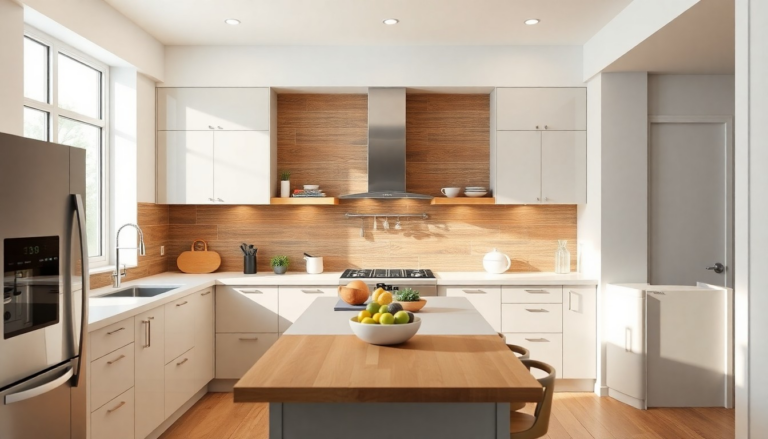19 Garage Workshop Layout Ideas to Maximize Space and Efficiency

Your garage workshop should be more than just a cluttered corner with a workbench and scattered tools.
It should be a well-oiled machine—a place where projects come to life, tools are always within reach, and every square inch is optimized for efficiency.
Whether you’re an experienced woodworker, a weekend DIY warrior, or someone setting up a workspace for the first time, the right layout can make all the difference.
1. The Classic Wall-Mounted Tool Storage Layout
If your tools are scattered around like puzzle pieces with no picture to guide you, a wall-mounted storage system will change your life.
Pegboards, magnetic strips, and slat walls allow you to keep everything visible and accessible.
Studies show that workers spend up to 30% of their time searching for misplaced tools, so organizing them on the wall eliminates wasted time.
2. The U-Shaped Workshop for Maximum Reach
A U-shaped layout puts everything within arm’s reach, making it ideal for small garages.
Place your workbench at the center and install shelving along three walls to create an efficient workspace where tools, materials, and supplies are always nearby.
3. The Mobile Workstation Setup for Flexibility
If you hate feeling boxed in, a mobile workstation layout is your best friend.
Rolling tool carts, collapsible tables, and mobile workbenches allow you to rearrange your setup as needed.
This is perfect for those who work on cars, woodworking, or metal fabrication and need space to move around freely.
4. The L-Shaped Workshop for Small Spaces
An L-shaped layout utilizes two walls, leaving the center of the garage open for bigger projects or vehicle storage.
This works well if you need to balance workshop space with parking.
Keep heavy-duty tools like table saws or drill presses against one wall and lighter, everyday tools on the other.
5. The Overhead Storage and Loft System
Garages are often vertical goldmines—and most people don’t take advantage of it.
Installing overhead shelves, hanging storage racks, or even a small loft can free up valuable floor space.
Use overhead storage for lumber, seasonal tools, or bins of rarely used supplies.
6. The Fold-Down Workbench for Multi-Use Garages
If you need your garage for parking and a workshop, a fold-down workbench is the way to go.
Mounted on the wall with sturdy hinges, it can be folded up when not in use.
Add wall-mounted storage for tools, and you have an instant workspace without sacrificing garage space.
7. The Corner Workshop Layout for Compact Efficiency
Don’t have much room? A corner workshop can transform even the smallest garage into a functional workspace.
Install shelving, pegboards, and a compact workbench in one corner while leaving the rest of the garage open.
8. The Dedicated Power Tool Station
If you use power tools regularly, consider designing a dedicated power tool station with a built-in dust collection system, power strip, and tool mounts.
Keep frequently used tools like drills, saws, and grinders in one location for seamless workflow.
9. The Work Triangle Layout for Maximum Productivity
Inspired by the kitchen work triangle, this layout places the workbench, tool storage, and materials area in a triangular formation, minimizing movement and maximizing efficiency.
Studies show that minimizing steps between key work areas can increase productivity by up to 25%.
10. The Heavy-Duty Mechanics Bay
If you work on cars or motorcycles, your garage needs a mechanics bay setup.
This means a dedicated tool chest, rolling creeper seat, hydraulic lift (if space allows), and ample lighting.
Keep oil, lubricants, and frequently used tools within arm’s reach.
11. The Smart Workshop with Digital Integration
Want a futuristic garage? Install smart lighting, Bluetooth-enabled tool trackers, and voice-activated power strips.
This way, you can control your workspace with a simple voice command, making late-night projects easier and more enjoyable.
12. The Dust-Free Woodworking Layout
If you work with wood, dust control is crucial.
Set up a dedicated dust collection system, keep your sander, saw, and planer in one area, and install sealed storage bins to prevent dust buildup.
A clean shop isn’t just nice—it’s better for your health and the longevity of your tools.
13. The Hybrid Workshop for Multi-Purpose Use
A hybrid workshop layout is ideal for those who do a mix of woodworking, metalworking, and home repairs.
Separate zones for cutting, assembly, and finishing help keep materials organized and the workflow smooth.
14. The Fully Insulated and Climate-Controlled Workshop
If you spend hours in your garage, temperature control matters.
Install insulation, a mini-split heater/AC unit, and a dehumidifier to maintain a comfortable and rust-free environment.
15. The Built-In Workbench with Storage Below
A built-in workbench with storage underneath is a simple yet powerful solution.
It keeps tools, screws, and materials neatly stored, reducing clutter and making everything easily accessible.
16. The Industrial Pipe Shelving and Workstation Combo
Love an industrial look? Install shelving made from black iron pipes and reclaimed wood.
This setup not only looks rugged and stylish but is also incredibly durable.
17. The Open Floor Plan Layout for Maximum Movement
For garages used for large-scale projects, keep the center open and move storage to the perimeter.
This allows easy movement, better airflow, and space for assembling big projects.
18. The LED-Lit Workshop for Better Visibility
Poor lighting ruins precision work.
Install LED strip lighting under shelves, overhead bright white lights, and task lighting over the workbench for a well-lit space that minimizes eye strain.
19. The Ultimate DIYer’s Dream Workshop
This all-in-one workshop includes wall-mounted storage, a mobile workbench, pegboards, built-in power strips, and separate zones for different tasks.
It’s the perfect mix of efficiency, organization, and creativity.
The right garage workshop layout can make all the difference.
Whether you need to maximize a tiny space or create a high-end DIY haven, the key is organization, accessibility, and adaptability.






